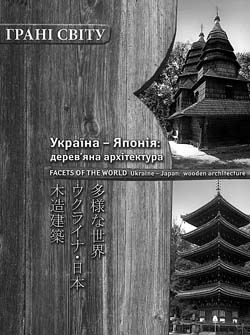Dialogue of cultures
Ukraine’s first trilingual book wins prize at international book exhibit in Miensk
The richly illustrated album Ukraine-Japan: Wooden Architecture, issued last year by the Kyiv publishing house Hrani-T, has won a Diploma 1st Class for best publication at the 14th International Book Exhibit and Fair in Belarus. It is Ukraine’s first trilingual book, with texts in Ukrainian, English, and Japanese.
Author and researcher Halyna Shevtsova writes in the foreword that the notion of Ukrainian and Japanese wooden architectures being related seems strange at first, but she was fortunate to familiarize herself in sufficient depth with both countries’ architectures. The closer she studied moss-grown roofs, ruddy crossbeams ravaged by time, and the fragile frameworks of the verandas and galleries that are an identical feature of churches and houses in both Ukraine and Japan, the deeper she inhaled the sweetish, pungent smell of timber mixed with the aroma of incense sticks in Japan and wax candles and church incense in Ukraine, the more she realized that there are strong similarities.
There are no differences between typical Carpathian and Japanese landscapes. The terrain is similar, as well as the color of the vegetation and the damp, smoky, impressionistic atmosphere. Summer rains are equally heavy, and in winter Japanese highland villages are buried under snow like their Carpathian counterparts. Perhaps this is the reason behind the similarities of the two countries’ wooden church architecture.
The other foreword is written by Professor Toshio Sakurai of Kinki University. The album contains a concise comparative survey of the two ancient cultures of wooden architecture. The rest of the album is devoted to colorful photographs. One side of the centerfold shows examples of Japanese wooden architecture and on the other side, examples of Ukrainian wooden architecture: chapels, belfries, gates, bridges, gravestone pillars, torii (traditional Japanese gates), churches, pagodas, cantilevers, houses, and barns. The layout helps to make comparisons.
Some pages contain blank spaces, like in puzzles, and readers are asked to find up to 5, 7, or 11 differences. One photograph shows a village home under a thatched roof, surrounded by mallow. Your first guess would be that this building is from a 19th-century Ukrainian village, located in a museum-preserve. Wrong! It is a Gassho-zukuri village home from the town of Shirakawa-go in Gifu Prefecture. The people of Japan, the land of the Rising Sun, regard mallow as a typically Japanese plant. There is an incredible similarity between the gates of the Hutsul Church of the Annunciation (1587) in Kolomyia, Ivano-Frankivsk oblast, and those of Zuiganji Monastery in Matsushima, Miyagi Prefecture. There are many other stunning similarities.
“We have an inner need to compare our rich and complex Ukrainian culture to as many other cultures in the world as possible,” says Diana Klochko, the chief editor of Hrani-T Publishers. “This is a most interesting and useful activity, as it promotes an increase in self-appraisal and adds to our knowledge of ourselves.”
Leafing through this album, you feel like spending a weekend in the Carpathians this spring. Of course, a trip to Japan would be great for making comparisons. Most likely I will travel to Chernihiv oblast, where there is an amazing wooden Baroque church in the village of Svarychivska in Ichnia raion.






